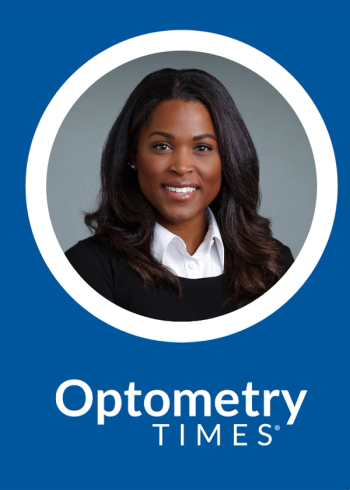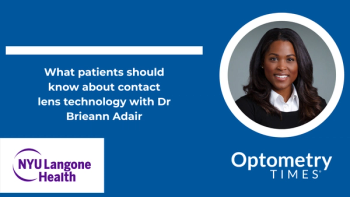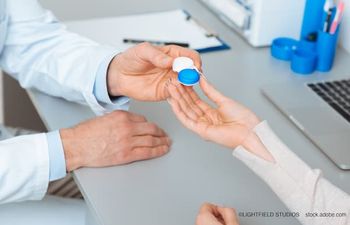
- June digital edition 2020
- Volume 12
- Issue 6
Patients aren’t hearing contact lens care information
Doctors and staff need to better communicate recommendations to contact lens wearers.
The gap between what providers say about contact lens wear and care practices and what the patient hears needs to be addressed in order to prevent infection issues and improve wearing comfort. There is evidence of greater compliance with hydrogen peroxide systems versus multipurpose systems.
An estimated 45 million U.S. residents enjoy the benefit of contact lens wear, but many of them might be at increased risk for complications stemming from improper wear and care.1
Unlike daily disposable, single-use contact lenses, those with longer replacement schedules must be maintained. Contact lens solutions perform the essential functions of disinfecting, cleaning, and preserving the lenses to prevent infection and improve wearing comfort.2
Patient-doctor disconnect
Far too often, the contact lens care regimen is given too little attention during the annual eye exam. Two surveys conducted to assess contact lens education revealed that one-third (32.9 percent) of contact lens wearers over 18 years of age recalled never hearing any contact lens wear and care recommendations, and only 19.8 percent recalled being told to avoid “topping off” their contact lens solutions.
Yet there is a disconnect between what the patient hears and what the provider says. The same survey reported that the majority of providers stated they shared care recommendations always or most of the time at initial visits, regular checkups, and at complication-related visits.3
This gap between what providers say and what the patient hears might be a factor in the large proportion of contact lens wearers reporting behaviors that place them at risk for contact lens-related complications.4 Addressing this gap might improve contact lens wear and care practices.
Patient recommendations
So, how does a busy practice accomplish this? Fortunately, there are resources available. The American Optometric Association makes the following recommendations for contact lens wearers:5
– Always wash and dry hands before handling contact lenses
– Carefully and regularly clean contact lenses as directed by your eye doctor. Rub the contact lenses with fingers and rinse them thoroughly before soaking the lenses overnight in multipurpose solution that completely covers each lens
– Store lenses in the proper lens storage case and replace the case every 3 months or sooner. Clean the case after each use, and keep it open and dry between cleanings
– Use only products recommended by your eyecare practitioner to clean and disinfect your lenses. Do not use saline solution and rewetting drops to disinfect lenses—that is not what they are designed to do
– Use fresh solution to clean and store contact lenses. Never reuse old solution. Change contact lens solution according to the manufacturer’s recommendations, even if you don’t wear the lenses daily
– Always follow the recommended contact lens replacement schedule prescribed by your eye doctor
– Remove contact lenses before swimming or entering a hot tub
– See your eye doctor for regularly scheduled contact lens and eye examination
The American Academy of Ophthalmology also has recommendations for contact lens care,6 and the Centers for Disease Control and Prevention also has poster and patient information sheets available.7
Hydrogen peroxide
Finally, a word about an old stand-by: hydrogen peroxide. Despite its well-established disinfection and safety benefits, the use of hydrogen peroxide lens care systems remains low in comparison with multipurpose solution use.8 Hydrogen peroxide care systems currently account for about 25 percent of lens care recommendations by U.S. practitioners.9
Noncompliant contact lens care behaviors are common among multipurpose solution users, including “topping off” solution, failure to rub and rinse lenses, and infrequent lens case cleaning and replacement.10 Hydrogen peroxide lens care systems are easy to use and limit the number of steps necessary to achieve disinfection.
There is evidence of greater compliance with hydrogen peroxide care systems versus multipurpose care systems. A 2007 survey found compliance with directions for use was 100 percent among the users of a one-step hydrogen peroxide lens care system, in comparison with 37 percent among multipurpose system users.11
Hydrogen peroxide lens care systems provide practitioners with a means to address many of the concerns with lens care noncompliance. It definitely has its place in our arsenal of lens care regimens.
References:
1. Cope JR, Collier SA, Nethercut H, Jones JM, Yates K, Yoder JS. Risk behaviors for contact lens-related eye infections among adults and adolescents—United States, 2016. MMWR Morb Mortal Wkly Rep. 2017 Aug 18;66(32):841-845.
2. Bloise L. Contact lens care and maintenance. J Fr Ophtalmol. 2017 Apr;40(4):329-337.
3. Konne NM, Collier SA, Spangler J, Cope JR. Healthy contact lens behaviors communicated by eye care providers and recalled by patients – United States, 2018. MMWR Morb Mortal Wkly Rep. 2019 Aug 16;68(32):693-697.
4. Cope JR, Collier SA, Rao MM, Chalmers R, Mitchell GL, Richdale K, Wagner H, Kinoshita BT, Lam DY, Sorbara L, Zimmerman A, Yoder JS, Beach MJ. Contact lens wearer demographics and risk behaviors for contact lens-related eye infections—United States, 2014. MMWR Morb Mortal Wkly Rep. 2015 Aug 21;64(32):865-870.
5. American Optometric Association. What You Need to Know About Contact Lens Hygiene & Compliance. Available at: https://www.aoa.org/patients-and-public/ caring-for-your-vision/contact-lenses/what-you-need-to-know-about-contact-lens-hygiene-and-compliance. Accessed 5/26/20.
6. Boyd K. How to Take Care of Contact Lenses. Am Acad Ophthalmology. Available at. https://www.aao. org/eye-health/glasses-contacts/contact-lens-care. Accessed 5/26/20.
7. Centers for Disease Control and Prevention. CDC-INFO On Demand—Publications. Available at: https://wwwn.cdc.gov/pubs/cdcinfoondemand. aspx?ProgramID=192. Accessed 5/26/20.
8. Nichols JJ. Contact lenses 2016. CL Spectrum. 2017 Jan;32(1):22-25,27,29,55.
9. Chalmers RL. A fresh look at one-step hydrogen peroxide disinfection. Rev Optom. 2014 Aug. Available at: https://www.reviewofoptometry.com/article/a-fresh-look-at-one-step-hydrogen-peroxide-lens- disinfection-49856. Accessed 5/26/20.
10. Guthrie S, Dumbleton K, Jones L. Is there a relationship between care system and compliance? Contact Lens Spectr. 2016 Apr;31(4):40-43.
11. Dumbleton K, Richter D, Bergenske P, Jones LW. Compliance with lens replacement and the interval between eye examinations. Optom Vis Sci. 2013 Apr;90(4):351-8.
Articles in this issue
over 5 years ago
Moncler Lunettes sunglass and eyeglass collection 2020over 5 years ago
Telehealth success hinges on better toolsover 5 years ago
Lactoferrin levels can diagnose dry eye diseaseover 5 years ago
Resolved cotton-wool spot leaves RNFL defect in its wakeover 5 years ago
11 things my patient wished her previous OD had told herover 5 years ago
Proper documentation helps assure prior authorizationsover 5 years ago
What a practice owner would advise her younger selfover 5 years ago
OCT, OCTA show promise in screening for DRNewsletter
Want more insights like this? Subscribe to Optometry Times and get clinical pearls and practice tips delivered straight to your inbox.





